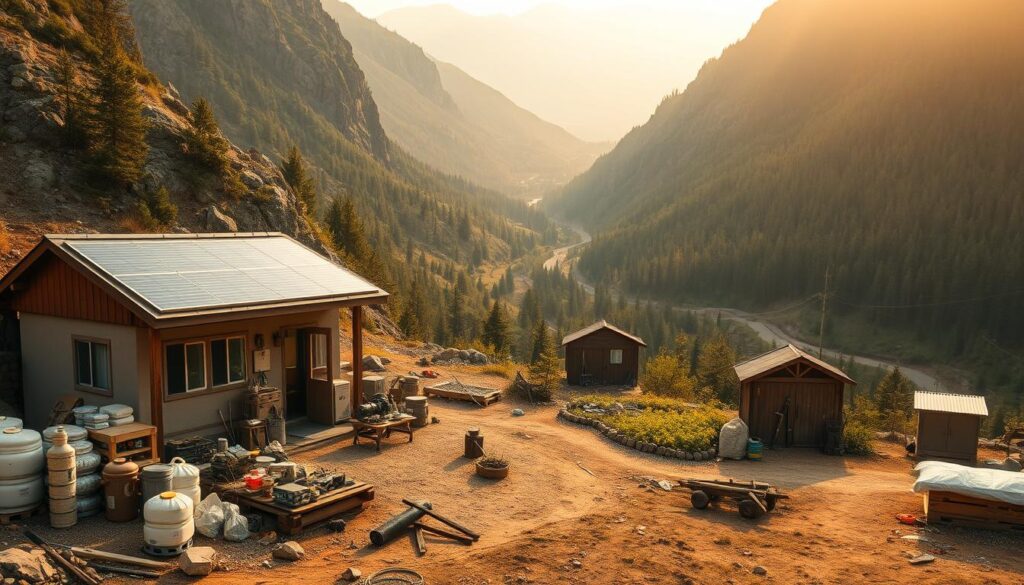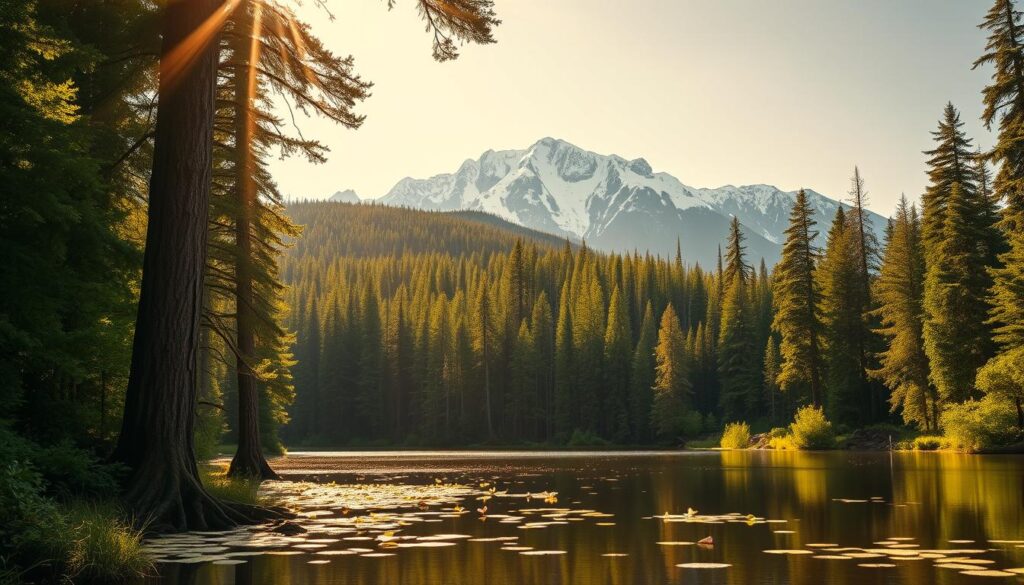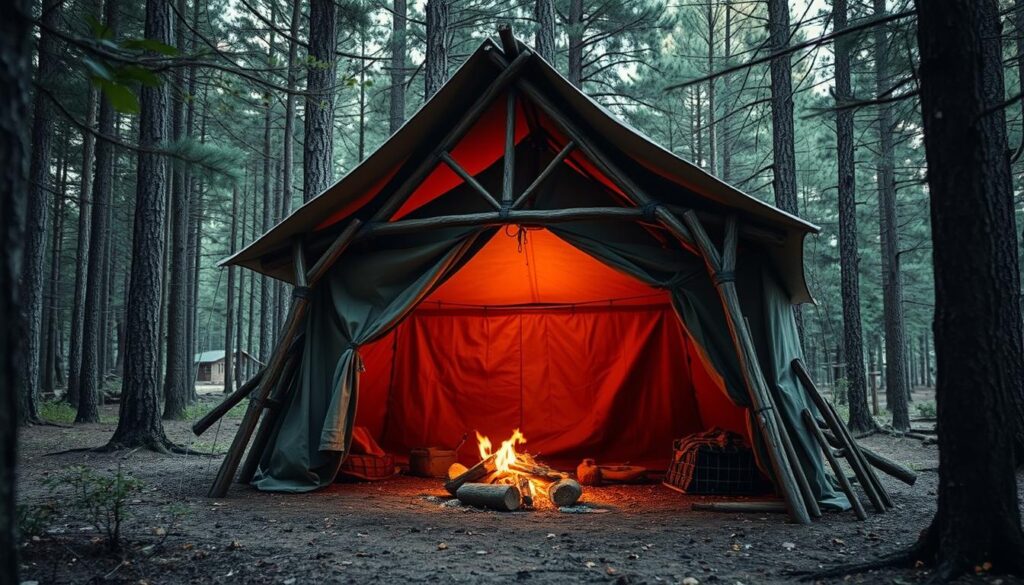When I started learning about emergency preparedness, I came across terms like “Get out of Dodge” (GOOD). I also learned about BOL and BOB (Bug Out Bag). These terms showed how vital it is to have a safe place to go during disasters or civil unrest.
Creating my ultimate emergency preparedness site was a key step. A Bug out location is more than just a safe spot. It’s a strategic place where you can survive and even thrive until things get better.
I aimed to make a secure and self-sufficient haven. To do this, I looked at several things. These included how easy it is to get there, how safe it is, and how sustainable it is.
Key Takeaways
- Understanding the importance of having a Bug Out Location.
- Identifying key factors for designing an emergency preparedness site.
- Considering accessibility and safety in the design.
- Ensuring sustainability of the Bug Out Location.
- Preparing a Bug Out Bag as part of the overall preparedness plan.
The Importance of a Bug Out Location (BOL)
A Bug Out Location, or BOL, is a safe place during big emergencies. It’s key to any emergency plan. A BOL is a spot where people can go when their home is not safe anymore.
Knowing about BOLs is important. A BOL is not just any place; it’s a special spot for safety and survival. It could be a cabin, a shelter, or an RV, all designed for emergencies.
Understanding the Concept of BOL
A BOL is a backup plan. It’s a place with the resources and safety needed in emergencies. A good BOL considers many things like how easy it is to get to, how safe it is, and how long you can stay.
Why Every Prepper Needs a BOL
For preppers, a BOL is essential. A BOL keeps families safe, stores supplies, and helps stay independent during crises. It’s a smart move for dealing with unexpected disasters.
- A BOL is a safe place from disaster dangers.
- It’s great for storing important supplies.
- A good BOL can support living for a long time, like growing food and managing waste.
Location vs. Preparedness: Finding the Right Balance
Finding the right BOL is hard. The location is important, but so is being ready. You need the right setup, supplies, and skills for survival.
When picking a BOL, look at the location and how ready it is. Think about shelter, water, food, security, and ways to communicate.
In short, a Bug Out Location is critical for any emergency plan. By understanding BOLs, their importance, and balancing location and readiness, people can better face emergencies.
Choosing the Right Location for My BOL
Choosing the right spot for my bug out location (BOL) was key. It had to be a place for fun and a safe spot in emergencies.
I thought about how far it should be from my home. I picked a spot 1 to 3 hours away by car. This was far enough to be safe but close enough to get to easily.
Assessing Climate and Weather Conditions
The weather was very important. I wanted a place safe from bad weather like hurricanes and floods.
I looked at past weather and talked to locals. This helped me see if the place was right for me.
Proximity to Essential Resources
Having water, food, and fuel nearby was important. I wanted a place with a natural water source and land for growing food.
| Resource | Importance | Considerations |
|---|---|---|
| Water | High | Access to a river, well, or rainwater collection system |
| Food | High | Arable land for gardening, possible for livestock |
| Energy | Medium | Solar, wind, or hydro power possible |
Evaluating Safety and Security Factors
Safety was my top concern. I looked at crime rates and hazards like industrial sites.
“The security of a location is not just about the absence of threats but also about the presence of opportunities for self-defense and the ability to sustain oneself.”
I also thought about how the land could help keep me safe. Using the terrain for defense was a big plus.
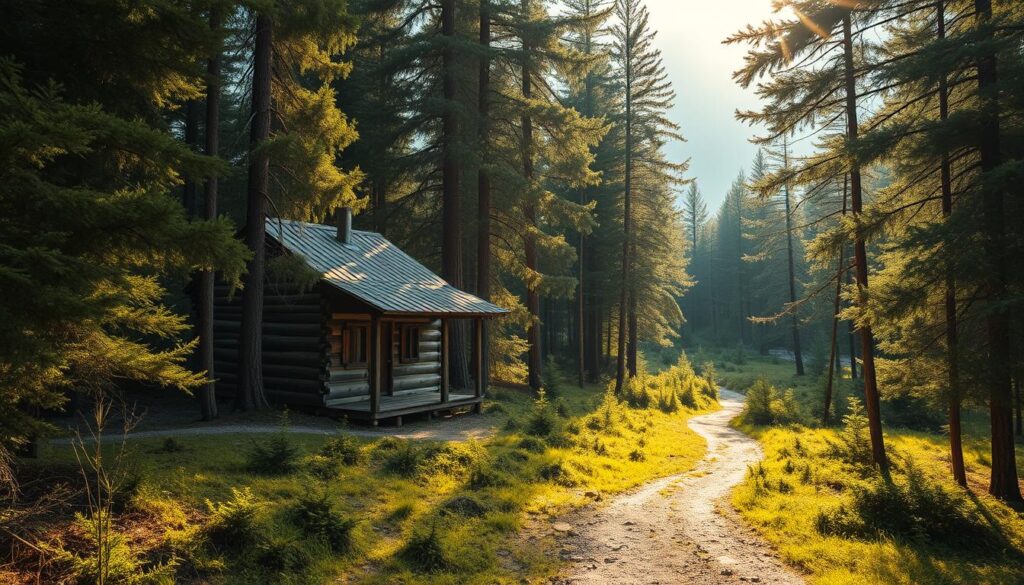
After weighing all these factors, I found the perfect spot for my BOL. It’s safe, sustainable, and easy to get to.
Land Acquisition and Legal Considerations
Setting up a prepper compound means knowing the law as much as finding land. You’ll need to take several steps. These include checking local laws and choosing how to buy the land.
Researching Property Laws and Zoning
It’s key to know the property laws and zoning before buying land for your BOL. Laws on land use change a lot by county. So, you must check with your county to know the rules. For example, some Utah counties require a working well before building.
“Understanding local zoning laws is key to avoid legal problems with your BOL.” –
To follow the rules, do the following:
- Look at county zoning maps and rules.
- Talk to local officials or a real estate lawyer.
- Make sure there are no building or infrastructure restrictions.
Purchasing vs. Leasing Options
After finding a good spot, you must choose between buying or leasing the land. Each option has its pros and cons.
| Option | Advantages | Disadvantages |
|---|---|---|
| Purchasing | Long-term control, can customize | High costs upfront, own maintenance |
| Leasing | Lower costs upfront, flexible | Less control, lease can end |
Your choice should depend on your money situation, future plans, and the lease or sale agreement details.
Assessing Accessibility and Road Conditions
The ease of getting to your relocation site is very important. It affects how useful it is, mainly in emergencies. Check the road to your property and think about these points:
- The state of the access roads.
- Any seasonal issues like snow or floods.
- Options for improving or upgrading the roads.
By looking at these things, you can make sure your BOL is easy to get to, no matter the weather or time of year.
Designing the Layout of My BOL
The layout of my BOL is more than a blueprint; it’s a survival strategy. A good layout makes my Bug Out Location secure, functional, and sustainable for the long haul.
I looked at several key factors before designing my BOL. These include supply options, escape routes, accessibility, seclusion, and water supply. These elements are vital for my BOL’s success.
Key Features to Include in My Design
In designing my BOL, I focused on essential features. These features improve its functionality and security. Some of these features include:
- Defensible Position: Making sure my BOL is in a secure spot that’s easy to defend.
- Sustainable Resources: Adding renewable energy and a reliable water supply.
- Communication Means: Having a way to communicate, like a radio or satellite phone.
Prioritizing Openness for Defense
Openness is key in my BOL’s design for defense. An open layout helps with surveillance and lowers ambush risks. As a prepper once said,
“A clear line of sight is your best defense.”
To achieve openness, I considered a few things:
- Clearing the area around my BOL of any obstructions or hiding spots.
- Creating a perimeter that’s easy to watch.
- Ensuring my BOL is visible from afar to scare off threats.
Space Optimization for Long-Term Living
Optimizing space is vital for long-term living in my BOL. I designed the layout to use space well, ensuring comfort and function.
I did this by:
- Choosing furniture and equipment that serves more than one purpose.
- Using efficient storage solutions.
- Designing a layout that makes movement and access easy.
By carefully designing my BOL’s layout, I’ve made a secure, functional, and sustainable survival shelter. It meets my needs in a crisis.
Building Infrastructure for My BOL
Creating a strong infrastructure is key to making my bug out location a lasting emergency preparedness site. A well-built setup helps me face and bounce back from disasters. This makes my disaster retreat a safe place.
When planning my BOL’s infrastructure, several important parts need attention. First, I must pick a shelter. Options include cabins, tents, or RVs, each with its own benefits and drawbacks. For example, a cabin is sturdy and weather-resistant, but more expensive. Tents are cheaper and easy to move, while RVs offer a mix of comfort and mobility.
Shelter Options: Cabin, Tent, or RV?
Choosing the right shelter depends on durability, cost, and personal taste. A cabin is durable and long-lasting, perfect for harsh weather. If I need to move around, a tent or RV might be better. For more tips on picking the right bug out location, check out this resource.
Water and Waste Management Solutions
Good water and waste management are essential for living in my BOL. I need a system for collecting, storing, and purifying water, and managing waste. I can collect water through rain harvesting or drilling a well. For waste, septic systems or composting toilets are good choices to protect the environment.
Effective waste management keeps my BOL clean and healthy. It’s important to plan for both gray and black water to keep my disaster retreat safe.
Energy Sources: Solar, Wind, or Generator
Energy is vital for my BOL, powering important systems and keeping me comfortable. I can use solar, wind, or generators for power. Solar panels are clean and quiet, making them great for off-grid living. Wind turbines are renewable but need wind to work well. Generators are traditional but reliable for when there’s no sun or wind.
Using different energy sources ensures I always have power. This boosts my emergency preparedness site‘s sustainability. It meets my immediate needs and helps me become more self-sufficient over time.
Creating Sustainable Food Sources
To ensure long-term survival, I’ve focused on developing a sustainable food system within my Bug Out Location (BOL). The ability to produce food on my land will vary widely depending on climate, soil conditions, and access to water.
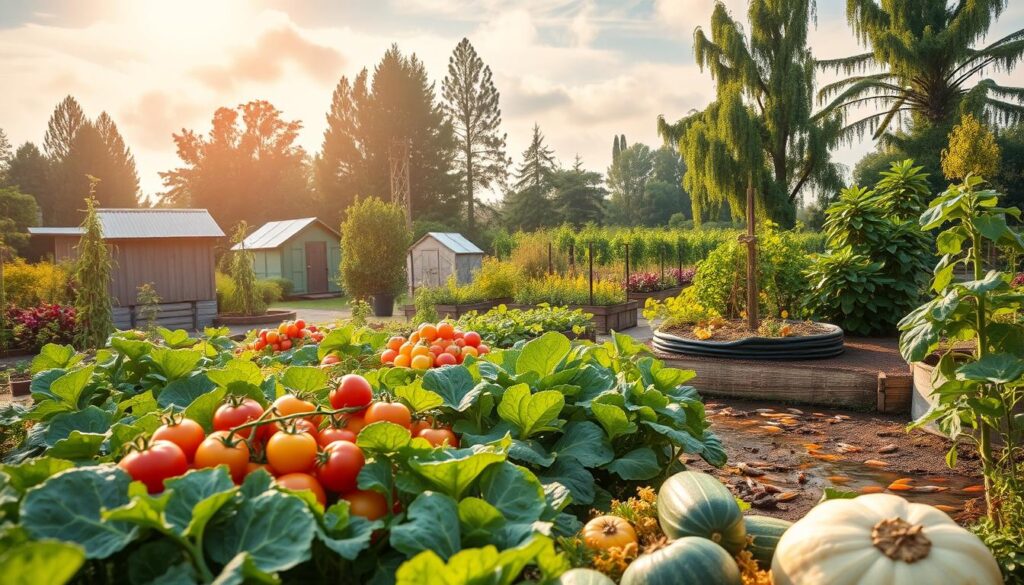
When planning my off-grid hideout, I had to seriously consider these factors to grow my own food in the event of an emergency. A well-planned garden is the cornerstone of food security, providing fresh produce year-round.
Starting a Garden: Vegetables and Herbs
I’ve started by creating a garden that includes a variety of vegetables and herbs. This not only ensures a diverse diet but also helps in maintaining soil health through crop rotation.
- Choose hardy, climate-resilient varieties.
- Implement companion planting to reduce pests.
- Use natural fertilizers to maintain soil fertility.
Raising Livestock for Food Security
Raising livestock is another key part of my food security plan. Animals like chickens, rabbits, and goats provide meat, dairy, and eggs, making my diet more nutritious.
When selecting livestock, I considered factors like climate adaptability and the space available in my wilderness refuge.
Foraging and Hunting: Skills to Master
In addition to gardening and livestock, I’ve learned foraging and hunting skills to supplement my food supply. Knowing which wild plants are safe to eat and how to hunt local wildlife is essential for survival.
These skills not only provide food but also connect me with nature and enhance my self-sufficiency in the BOL.
Establishing Security Measures
To keep my BOL safe, I’ve set up a detailed security plan. It has many layers of protection, making it a secure place for relocation.
Physical Security: Fencing and Barriers
Securing my prepper compound starts with physical barriers. I’ve put up strong fencing around the whole area.
Fencing Options:
- Chain-link fencing for durability
- Wooden fencing for camouflage
- Barbed wire or electric fencing for enhanced security
Surveillance Options: Cameras and Alarm Systems
Along with physical barriers, I’ve added surveillance cameras and alarm systems. They help me keep an eye on my BOL.
| Surveillance Component | Purpose |
|---|---|
| CCTV Cameras | Monitor perimeter and key areas |
| Motion Sensors | Detect movement and trigger alarms |
| Alarm Systems | Alert me to possible breaches |
Developing a Defense Plan
A defense plan is key for my BOL. It outlines steps for different situations, like intruder alerts and natural disasters.
Key Components of a Defense Plan:
- Identifying possible threats
- Setting up communication protocols
- Doing regular drills and training
Stockpiling Supplies and Essentials
To be self-sufficient, I focus on gathering essential supplies for my bug out location. This requires careful planning and thinking about what’s needed to survive in emergencies.
A bug out location needs food, water, and medical facilities. Non-perishable food items are key because they last long without refrigeration. It’s also important to have a clean water source, like a well or a water filter.
Assessing the Must-Have Supplies
When picking out must-have supplies, I look at several important areas. These include:
- Food and water: Non-perishable food and a reliable water source.
- Medical supplies: First aid kits, medicines, and injury treatment tools.
- Tools and equipment: Essential tools for self-sufficiency, like generators, solar panels, and repair kits.
Having these supplies ready can make my bug out location much more effective.
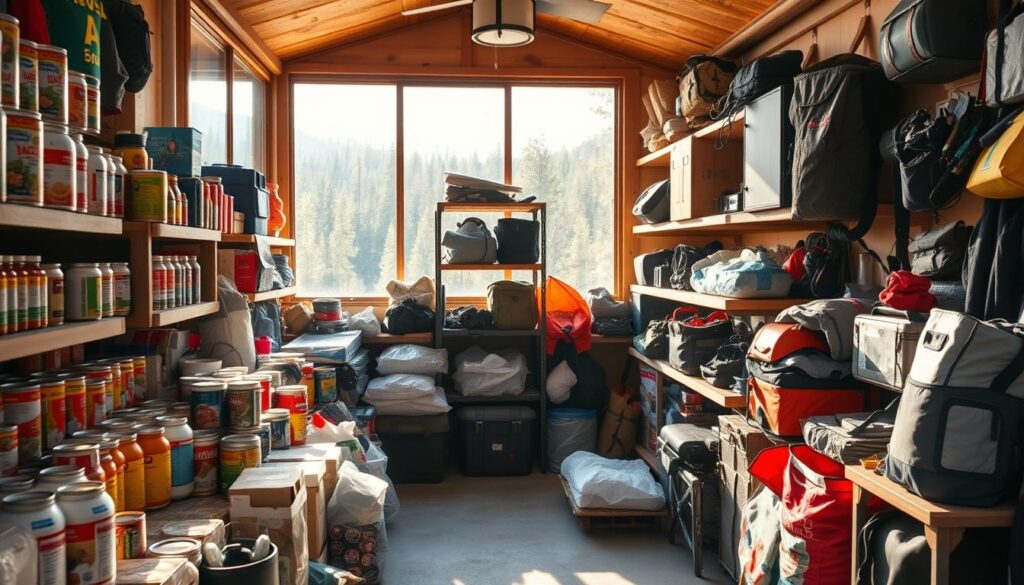
Rotating Food and Medical Supplies
It’s important to regularly check and replace supplies. This keeps them usable and effective. For example, I replace my food stock every six months to avoid expired items.
Medical supplies also need regular checks. This includes looking at bandages, the shelf life of medicines, and if medical equipment works.
Tools and Equipment for Self-Sufficiency
Tools and equipment are key for self-sufficiency at my bug out location. Some must-haves include:
- Generators or solar panels for power.
- Water filtration systems or purification tablets.
- Repair kits for keeping equipment in good shape.
- First aid kits and medical tools.
By stockpiling and keeping these supplies up to date, my bug out location stays safe and ready for emergencies.
Preparing for Communication and Information
A good communication plan is key to a successful emergency site. In a Bug Out Location (BOL), it’s vital to communicate well and stay updated. This helps in survival and making smart decisions.
Developing a Communication Plan
Creating a communication plan has several steps. First, pick your main communication tools, like two-way radios or satellite phones. Make sure everyone knows how to use them. Backup power sources for these tools are also important.
Next, create a communication protocol. This means setting up a regular check-in time and a meeting spot if you get separated. It’s also good to have a plan for emergencies, like using special codes or signals.
Using Radio and Signal Equipment
Radio gear is a must in any plan. A hand-crank radio, for example, can give you vital info without needing batteries.
Other tools include ham radios for local and global contact, and satellite phones for direct emergency service calls. Knowing how to use these tools is essential for staying informed and talking to others.
Staying Informed: News and Weather Sources
Knowing what’s happening outside your BOL is as important as talking to each other. Using different news and weather sources helps in making smart choices about going out or preparing for weather.
“The most effective way to prepare for the unexpected is to stay informed and be proactive.”
A table summarizing different sources of information can be helpful:
| Source | Description | Usefulness |
|---|---|---|
| Hand-crank Radio | Provides news and weather updates without batteries | High |
| Ham Radio | Allows communication with local and global communities | High |
| Satellite Phone | Direct link to emergency services and outside world | Critical |
By having a solid communication plan and reliable info sources, you can greatly improve your emergency readiness.
Conducting Regular Drills and Assessments
To make sure my disaster retreat works well, I do regular training and checks. This helps me find and fix any weak spots in my bug out location (BOL).
Training is key to being ready. By doing drills often, I get to know my BOL’s layout and how its systems work. Regular drills also help me stay calm in emergencies.
Training for Real-World Scenarios
My drills mimic real-life situations that could affect my BOL. This includes practicing for natural disasters, security issues, and medical emergencies. Training for these helps me get better at handling them.
Evaluating My BOL's Preparedness
Checking my BOL’s readiness often is very important. I look at the state of my gear, if I have enough supplies, and if my systems work. I also check my BOL’s defenses to keep them strong.
Making Adjustments Based on Drills
What I learn from drills and checks helps me improve my BOL. This might mean updating my emergency plans, swapping out old gear, or changing my BOL’s layout. By always making it better, I know my BOL is safe and ready for me.
Being creative and prepared is what makes a good bug out location. The more I put into it, the better it gets. By doing drills and checks often, I’m sure my BOL will help me through tough times.
Building a Community Around My BOL
My journey to create a reliable wilderness refuge showed me that a strong community is key. A good prepper compound isn’t just about its shelter. It’s about the people who support it too.
Networking with other preppers has been a big step for me. It’s given me knowledge, resources, and experiences that have made my BOL better. For more tips on prepping and community building, check out Ready to Go Survival.
Establishing Mutual Aid Agreements
Creating mutual aid agreements has been vital for my community. These agreements mean we can count on each other in tough times. We share resources, offer shelter, and skills, building trust and cooperation.
One prepper said, “Prepping is more than just being ready yourself. It’s about being part of a community that faces challenges together.” This idea is at the heart of a prepper compound, where people work together to be stronger and more supportive.
Organizing Skill-Sharing Workshops
Hosting skill-sharing workshops has helped grow my community. Sharing knowledge and skills makes us all better and builds respect. We’ve learned about first aid, self-defense, and more.
As I keep working on my BOL and community, I know it’s all up to me. The success of my off-grid hideout depends on my creativity, preparation, and connecting with others. With a strong community, my refuge will stay safe and thriving, no matter what.
Reflecting on My BOL Experience
Preparing my Bug Out Location (BOL) has been a journey of self-discovery. It’s shown me that creating a relocation site is an ongoing process. It needs constant improvement and adaptation.
Practical Insights
I’ve learned starting early and being flexible is key. No location is perfect, so it’s important to adjust based on needs. My BOL is more than a shelter; it’s a sign of my commitment to self-reliance.
Future Plans
I’m now focusing on making my BOL more sustainable and secure. I’m looking into renewable energy and better water systems. I’m also working on a detailed defense plan for my safety.
A Journey of Self-Reliance
Preparing my BOL has taught me valuable skills. It’s shown me the importance of being ready for the unexpected. I hope my story inspires others to take charge of their preparedness.
FAQ
What is a Bug Out Location (BOL) and why do I need one?
A Bug Out Location is a safe spot where you can go in an emergency. It’s key for preppers because it offers a secure place to be ready for anything.
How do I choose the right location for my BOL?
When picking a BOL, think about the climate, resources nearby, and safety. Check the weather, how easy it is to get there, and any dangers to make sure it’s right for you.
What are the key features to include in my BOL design?
Focus on shelter, water, energy, and security when designing your BOL. Plan the layout to use space well for living and defending yourself.
How can I ensure food security in my BOL?
Start a garden, raise animals, and learn to forage and hunt to ensure food. These methods will keep you fed.
What security measures should I implement in my BOL?
Use fences, cameras, and alarms to secure your BOL. Also, have a defense plan to protect you and your supplies.
How often should I conduct drills and assessments in my BOL?
Do drills and checks often to keep your BOL ready. Practice and review your plans to stay prepared.
Can I build a community around my BOL?
Yes, having a community around your BOL is good. Connect with other preppers, make agreements, and share skills to make your BOL better.
How do I maintain my BOL’s infrastructure and supplies?
Check and fix your BOL’s parts like shelter and energy often. Also, swap out food and medical stuff and update your gear to stay self-sufficient.
What are the benefits of having an off-grid hideout or wilderness refuge?
An off-grid hideout or wilderness refuge offers a private and safe place. It lets you be independent and away from public services, which is great in emergencies.
How can I stay informed and communicate effectively from my BOL?
Make a communication plan and use radios and signals. Also, keep up with news and weather to stay informed from your BOL.

